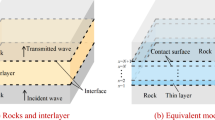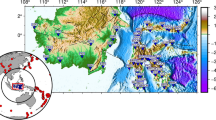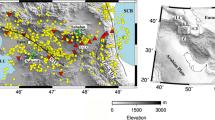Abstract
Anisotropy, a term used by seismologists to describe the variation of seismic wave velocity in different directions, is an excellent tool to examine the deformation (past and present) in the upper mantle. Seismic anisotropy beneath Sri Lanka region is investigated using core-refracted SK(K)S phases at three stations, namely MALK, PALK and HALK. Shear wave splitting measurements were done for ~30 high-quality waveforms recorded in the region, using the rotational correlation (RC), the minimum energy (SC), and the eigenvalue (EV) methods. The shear wave splitting measurement results in Sri Lanka show the presence of two anisotropic layers in the upper mantle, viz., NW–SE fast polarization direction for MALK and HALK, and NE–SW for the PALK stations in the upper layer; NNE–SSW for MALK and HALK, and NW–SE for PALK in the lower layer. Overall, fast polarization direction for Sri Lanka region is found to be NE–SW. The delay time in the upper and lower layer is found to be between 0.3–0.5 s and 0.6–0.9 s, respectively. The observed average delay time (1.2 s) in the lower layer of upper mantle describes a ~134 km thick anisotropic layer with 4% anisotropy beneath Sri Lanka region. Comparison of absolute plate motion (APM) direction with fast polarization directions indicate that the simple asthenospheric flow (SAF) model prevails in this region. On the other hand, comparison of maximum horizontal stress (Shmax) and the global positioning system (GPS) with the fast polarization direction indicates that there is partial contribution from lithospheric mantle. The anisotropy in Sri Lanka could be mainly governed by asthenospheric flow and partially due to lithospheric mantle.





Similar content being viewed by others
References
Altamimin Z, Rebischung P, Métlvler L and Collilleux X 2016 ITRF2014: A new release of the International Terrestrial Reference Frame modeling nonlinear station motions; J. Geophys. Res. 121 6109–6613.
Argus D F, Gordon R G, Heflin M B, Ma C, Eanes R J, Willis P, Peltier W R and Owen S E 2010 The angular velocities of the plates and the velocity of the Earth’s centre from space geodesy; Geophys. J. Int. 18 1–48.
Argus D F, Gordon R G and DeMets C 2011 Geologically current motion of 56 plates relative to the no–net-rotation reference frame; Geochem. Geophys. Geosyst. 12 Q11001.
Barruol G, Silver P G and Vauchez A 1997 Seismic anisotropy in the eastern United States: Deep structure of a complex continental plate; J. Geophys. Res. 102(B4) 8329–8348.
Bizhan A and Özacar A A 2017 M-split: A graphical user interface to analyze multilayered anisotropy from shear-wave splitting; Seismol. Res. Lett. 88(4) 1146–1155.
Booth D C, Crampin S, Evans R and Roberts G 1985 Shear-wave polarization near the North Anatolian fault–I. Evidence for anisotropy-induced shear-wave splitting; Geophys. J. R. Astron. Soc. 83 61–73.
Bowman J R and Ando M 1987 Shear-wave splitting in the upper-mantle wedge above the Tonga subduction zone; Geophys. J. R. Astron. Soc. 88 25–41.
Büchel G 1994 Gravity, magnetic and structural patterns at the deep-crustal plate boundary zone between west and east Gondwana in Sri Lanka; Precamb. Res. 66(1) 77–91.
Cooray P G 1982 Geological map of Sri Lanka (Ceylon), England; Cartographic Unit of ESR Ltd.
Cooray P G 1994 The Precambrian of Sri Lanka: A historical review; Precamb. Res. 66 3–18.
Dreiling J, Tilmann F, Yuan Xi, Haberland C and Seneviratne S W 2019 Crustal structure of Sri Lanka derived from joint inversion of receiver functions and seismic ambient noise using a Bayesian approach; J. Geophys. Res. 125 e2019JB018688.
Fontaine F R, Barruol G, Tommasi A and Bokelmann G H R 2007 Upper mantle flow beneath French Polynesia from shear wave splitting; Geophys. J. Int. 170 1262–1288.
Fouch M J and Rondenay S 2006 Seismic anisotropy beneath stable continental interiors; Phys. Earth Planet. Int. 158 292–320.
Gowd T N, Sriram Rao S V and Gaur V K 1992 Tectonic stress field in the Indian subcontinent; J. Geophys. Res. 97 11,879–11,888.
Gripp A E and Gordon R G 2002 Young tracks of hotspots and current plate velocities; Geophys. J. Int. 150 321–361.
Heintz M, Kumar V P, Gaur V K, Priestley K, Rai S S and Prakasam K S 2009 Anisotropy of the Indian continental lithospheric mantle; Geophys. J. Int. 179(3) 1341–1360.
Jade S, Shrungeshwara T S and Kumar K 2017 India plate angular velocity and contemporary deformation rates from continuous GPS measurements from 1996 to 2015; Sci. Rep. 7 11439.
Kennett B L N and Engdahl E R 1991 Travel times for global earthquake location and phase identification; Geophys. J. Int. 105 429–465.
Kreemer C, Blewitt G and Klein E C 2014 A geodetic plate motion and global strain rate model; Geochem. Geophys. Geosyst. 15 3849–3889.
Kröner A 1991 African linkage of Precambrian Sri Lanka; Geol. Rundschau 80(2) 429–440.
Kumar N, Zeyen H, Singh A P and Singh B 2013 Lithospheric structure of southern Indian shield and adjoining oceans: Integrated modelling of topography, gravity, geoid and heat flow data; Geophys. J. Int. 194 30–44.
Kumar V P, Prakasam K S, Rai S S and Gupta S 2015 Upper-mantle anisotropy beneath the south Indian shield: Influenced by ancient and recent Earth processes; Lithosphere 7(2) 108–116.
Long M, Becker D and Thorsten W 2010 Mantle dynamics and seismic anisotropy; Earth Planet. Sci. Lett. 297(4) 341–354.
Mathavan V and Fernando G W A R 2001 Reactions and textures in grossular–wollastonite–scapolite calc–silicate granulites from Maligawila, Sri Lanka: Evidence for high-temperature isobaric cooling in the meta-sediments of the Highland Complex; Lithos 59(4) 217–232.
Milisenda C C, Liew T C, Hofmann A W and Kröner A 1988 Isotopic mapping of age provinces in Precambrian high-grade terrains: Sri Lanka; J. Geol. 96 608–615.
Milisenda C C, Liew T C, Hofmann A W and Köhler H 1994 Nd isotopic mapping of the Sri Lanka basement: Update, and additional constraints from Sr isotopes; Precamb. Res. 66 95–110.
Mukherjee P, Borah K and Bora D K 2019 Nature of crust beneath Sri Lanka using teleseismic receiver function; J. Asian Earth Sci. 187 104096.
Mukherjee P, Borah K and Yadav A 2022 Crustal structure beneath the Precambrian Cratons of Gondwanaland and its evolution using teleseismic receiver function; Lithosphere 2021(Special 6) 2558277.
Pathirana H D N C 1980 Geology of Sri Lanka in relation to plate tectonics; J. Nat. Sci. Found. Sri Lanka 8(1) 75–85.
Rao M K, Kumar M R, Singh A and Rastogi B K 2013 Two distinct shear wave splitting directions in the northwestern Deccan Volcanic Province; J. Geophys. Res.: Solid Earth 118 5487–5499.
Roy S K, Srinagesh D, Saikia D, Singh A and Kumar M R 2012 Seismic anisotropy beneath the Eastern Dharwar craton; Lithosphere 4(4) 259–268.
Saikia D, Kumar M R, Singh A, Mohan G and Dattatrayam R S 2010 Seismic anisotropy beneath the Indian continent from splitting of direct S waves; J. Geophys. Res.: Solid Earth 115 1–15.
Savage M 1999 Seismic anisotropy and mantle deformation: What have we learned from shear wave splitting; Rev. Geophys. 37 65–106.
Silver P G and Chan W W 1988 Implications for continental structure and evolution from seismic anisotropy; Nature 335 34–39.
Silver P G and Chan W W 1991 Shear–wave splitting and subcontinental mantle deformation; J. Geophys. Res. 96 16,429–16,454.
Silver P G and Savage M K 1994 The interpretation of shear wave splitting parameters in the presence of two anisotropic layers; Geophys. J. Int. 119 949–963.
Vinnik L P, Makeyeva L I, Milev A and Usenko A Y 1992 Global patterns of azimuthal anisotropy and deformations in the continental mantle; Geophys. J. Int. 111(3) 433–447.
Walker K T, Nyblade A A, Klemperer S L, Bokelmann G H R and Owens T J 2004 On the relationship between extension and anisotropy: Constraints from shear wave splitting across the East African Plateau; J. Geophys. Res. 109 B08302.
Walker K T, Bokelmann G H R, Klemperer S L and Bock G 2005 Shear wave splitting around the Eifel hotspot: Evidence for a mantle upwelling; Geophys. J. Int. 163 962–980.
Wüstefeld A and Bokelmann G 2007 Null detection in shear–wave splitting measurements; Bull. Seismol. Soc. Am. 97(4) 1204–1211.
Wüstefeld A, Bokelmann G, Zaroli C and Barruol G 2008 SplitLab: A shear-wave splitting environment in Matlab; Comput. Geosci. 34(5) 515–528.
Yadav R and Tiwari V M 2018 Numerical simulation of present day tectonic stress across the Indian subcontinent; Int. J. Earth Sci. 107(7) 2449–2462.
Acknowledgements
We warmly thank Andreas Wüstefeld for his useful help in providing the SplitLab package. We thank Dr Radheshyam Yadav and Dr V M Tiwari, for providing us the maximum principal stress direction (Shmax) results for comparison. The comments from the anonymous reviewers are constructive and valuable that have greatly improved the manuscript. K Borah gratefully acknowledges the financial support by the Science and Engineering Research Board (SERB), India (Project No. MTR/2019/001260). Seismic waveform data has been obtained from Incorporated Research Institutions for Seismology (IRIS) Data Management Centre (DMC) and GEOFON Data Centre networks: GE (https://doi.org/10.14470/TR560404) and II (https://doi.org/10.7914/SN/II). Most of the data processing was done using Seismic Analysis Code (SAC) and figures were made using Generic Mapping Tools (GMT).
Author information
Authors and Affiliations
Contributions
SC: Data analysis, writing, revising and editing the original draft. KB: Supervision, discussion, revision, correction, improvement. AB: Editing, improvement. PM: Discussion, revision, corrections, improvement.
Corresponding author
Additional information
Communicated by Anand Joshi
Supplementary material pertaining to this article is available on the Journal of Earth System Science website (http://www.ias.ac.in/Journals/Journal_of_Earth_System_Science).
Supplementary Information
Below is the link to the electronic supplementary material.
Rights and permissions
About this article
Cite this article
Chandra, S., Borah, K., Barua, A. et al. Upper mantle anisotropy in Sri Lanka using shear-wave splitting analysis: Geodynamical implications. J Earth Syst Sci 132, 91 (2023). https://doi.org/10.1007/s12040-023-02107-z
Received:
Revised:
Accepted:
Published:
DOI: https://doi.org/10.1007/s12040-023-02107-z




